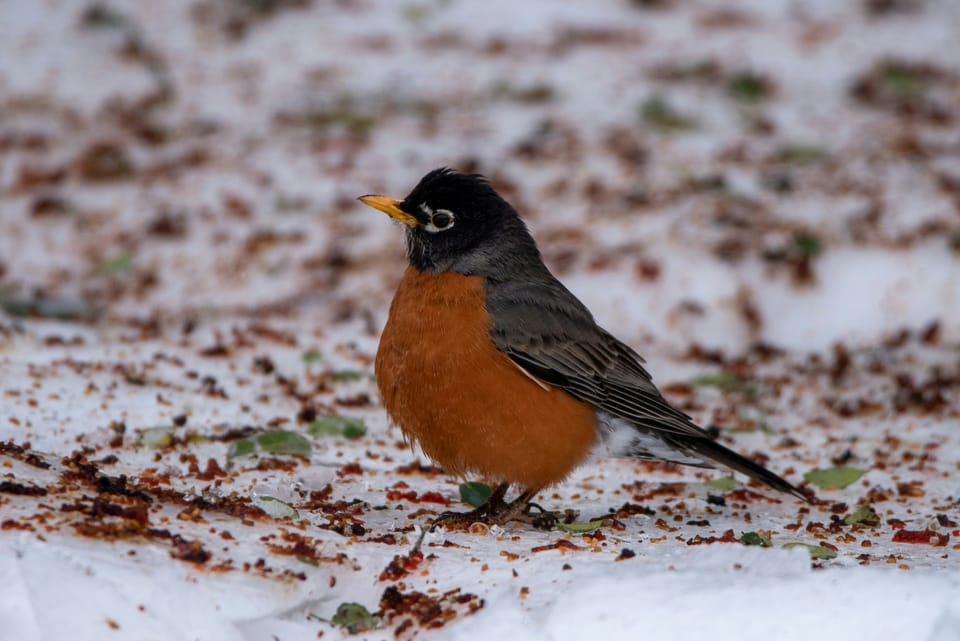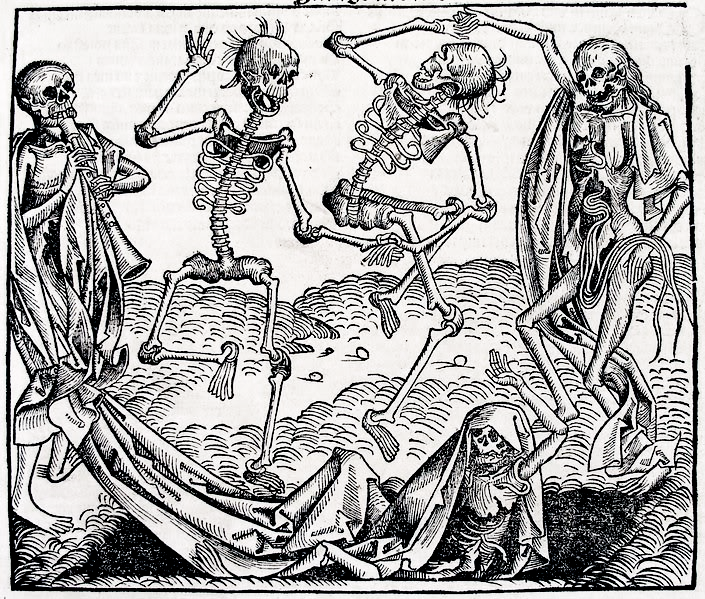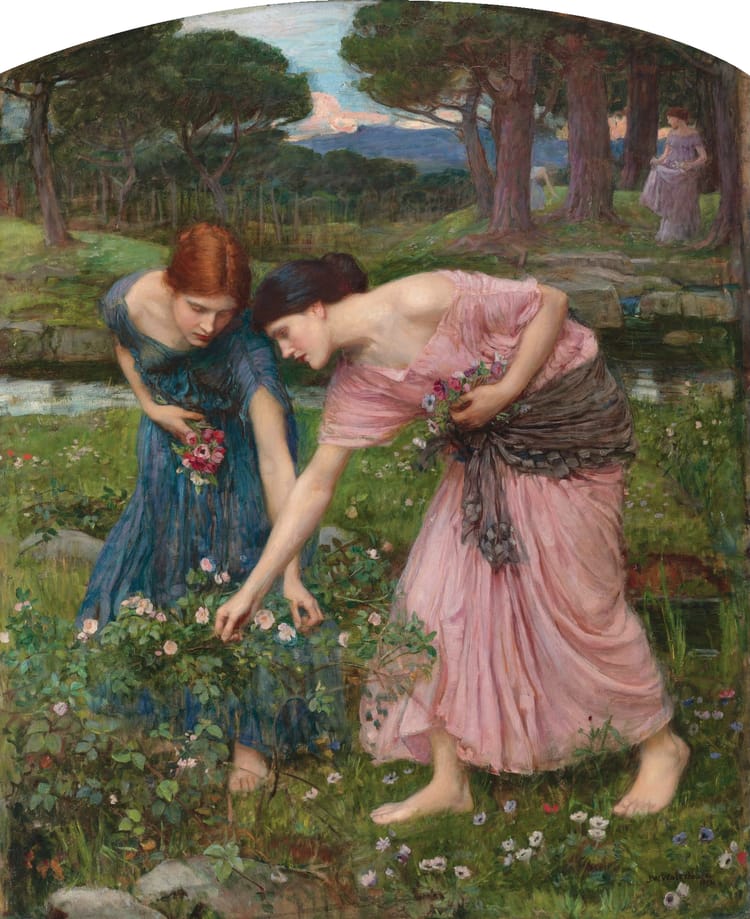Full Moon: Birdsong

It's Friday, and I am watching icicles melt to the sound of chickadees, titmice, cardinals, juncos, sparrows, and jays in the backyard. It's also Valentine's Day. Hello.
A couple of weeks ago, I wrote out some thoughts on the most recent holiday on the Wheel of the Year feeling close to a stand-in for Valentine's, which as itself I don't generally observe due to personal associations and my disinterest in what often feels like the modern holiday's prevailing straightness. But regardless of the precise timing, I do also feel as though all of February tends to stir something in my emotions — not the frenzied lust of May, but a powerful urge for connection, erotic in a broader sense than the sexual — and likewise in my own experience this month seems a common window for exploring or rekindling intimacy. Besides my catastrophic relationship that began on Valentine's Day a long time ago, superior examples include the tendency I've noticed over the past several years for my owner and I to have notably moving, transformative sexual encounters somewhere in February; and there are now a couple cases of either me confessing my attraction to someone else or someone confessing their interest in me.
I do not believe any of this is really an accident. Even beyond the divine aspects I wrote about for Gŵyl Fair, I'm sure that in the Northern Hemisphere there's a more mundane component: the brightening of the world elevating our energy and signaling us to start turning outward instead of remaining in wintry stasis. But as I noted in that earlier post, the association of love with St. Valentine's Day in particular has a folkloric origin, dating back to the medieval European view that now is the day when birds choose their mates. I find this piece of seasonal storytelling endlessly fascinating, because on the one hand it's largely inaccurate and erases the complexity of different bird species' breeding habits — and yet on the other hand birds, being crucial seasonal indicators overall, are certainly on the verge of doing something important here at the end of astronomical winter and start of solar spring.
So the following is a loving meditation on birds and fertility: the diverse mating patterns of birds even just in my own bioregion, and the place that birds hold in any fertile, abundant ecosystem. I'm no ornithologist, only a birding hobbyist whose ritual practice is brushing up more and more lately with the avian order compared to other animals. But if anyone reading is a fellow birder (or an ornithologist, for that matter), I would love to read your own perspective in response.
Myths of bird mating
Human sexual-social behaviors are often presumed to follow a very clear, universal formula where lifelong or at least serial monogamy is the default, whether or not queer sexualities are acknowledged. If there's any alternative view offered, it's the titillated, chauvinistic proposal of polygyny — that "human males" evolved to reproduce with as many "human females" as possible whereas those "human females" will only be attracted to the "best" "male" in their vicinity.[1] But the ideas of default monogamy or polygyny both hold very little water when examining the multidirectional promiscuity of our immediate primate ancestors, or when reviewing polls that have anywhere from 10% to 50% of respondents admitting to infidelity in a nominally monogamous relationship. Numbers like that suggest many of us, maybe a plurality, would choose to be intimate with multiple people at once even after adjusting for whatever portion of those incidents arose purely from relationship dissatisfaction.
Birds are often misunderstood in a similar fashion, which is especially odd when considering how there are thousands upon thousands of bird species whose breeding strategies and courtship tactics are unique outcomes of their evolutionary history. Admittedly, there is some truth to avian monogamy myths insofar as some variant of monogamy tends to prevail among most species, especially among songbirds. But it isn't the whole truth. Not all mated bird pairs stay together for life, either practicing serial monogamy instead, finding new mates when one dies or disappears, and sometimes choosing what ornithologists literally refer to as divorce (frequently, though not always, if the pair didn't successfully raise a brood that year). And besides all of those exceptions, a great many birds do not practice monogamy at all, favoring polygyny, polyandry, or something akin to "relationship anarchy"[2]; or they practice what's called social monogamy but not sexual monogamy, wherein a mated pair will raise offspring only with each other but will freely copulate with single or paired comrades in their area.
These distinctions all layer themselves on top of other varied behaviors in which birds actually incubate eggs, raise their young, etc. — the mothers, fathers, both, visiting babysitter figures, or unsuspecting birds exploited by parasitic brood species like the cuckoo. Likewise, birds "choosing" mates can be rather a misnomer in some cases; consensual sex is certainly the norm but some species, notoriously mallard ducks, are known for males[3] considering consent entirely optional.
Having said all of this, I understand overlooking many exceptions to the folkloric rule because of how interesting it is that overall, bird mating behaviors essentially resemble common patterns in humans. And in a way, this includes the cases of nonmonogamy and nonconsent. The stories we tell about birds can become stories about ourselves. But whatever stories we do tell, I think it could be universally agreed that birds do not all choose their mates on Valentine's Day or at any other point in February. Where I live, some birds that pair-bond have started that process already, but most will wait until it's warmer. I can't help thinking that this medieval myth arose because spring temperatures arrive sooner in Europe, and they may have arrived markedly early during the Medieval Warm Period. Even so, not all Eurasian birds begin breeding at the same time. Valentine's is a symbolic date.
Or is it? The more I have thought about it, the more I think there is a different but related story to tell here. Before I speculate further, however, I would like to look at several birds of my bioregion who demonstrate the variety in mating practices even just among songbirds.
Birds of N'dakinna
As usual, I am cautious about revealing my exact, local bioregion, but I'm comfortable occasionally mentioning that it's part of the traditional Abenaki homeland, which the Abenaki language names N'dakinna. The territory spans a portion of the northeastern Appalachian Mountains and several riverlands to the east; I live somewhere between the mountain foothills and those riverlands.
I have many favorite birds here, some of whom are iconic to the landscape and others of whom are seen across the continent or even further away. Many are not songbirds, either. But when it comes to evaluating the diversity of songbird breeding and courtship in my own area, I have thought a little while and landed on these examples. Unfortunately, it is hard to find their Abenaki names even when names are documented online from other indigenous languages, so I don't feel as if I am going to address them properly — but I did find one name, and in a couple cases I have found a better sense of how to render their names in English beyond their official colonial nomenclature.
The northern cardinal, perhaps better addressed as the redbird: Although these birds do have incidents of nonmonogamy or divorce, they are a very common example of local songbirds who often do mate exclusively for life. However, they have their own special courtship characteristics, and I admire them as a beautiful example of gender parity or even matriarchal qualities despite their marked sexual dimorphism and male territoriality. The male helps the female build a nest, and when courting the male feeds her food beak-to-beak. The pair will sometimes sing together, and they care for their offspring together. Everywhere rural that I've lived, I've always discovered a pair living nearby, and I've always loved watching their teamwork and magnificent colors, whether the male's brilliant scarlet or the female's serene grey. As year-round inhabitants of this region, they are always visible, but their breeding season starts roughly in March.
Kwikweskas, the "New World" robin: These birds are much more known for short-duration relationships. Sometimes they will reunite from one breeding season to the next, but it's more common that they will stay (relatively) monogamous one year and then find a new mate in the next. They are still somewhat egalitarian when it comes to parenting; the female handles more of the feeding, but both will aggressively defend the nest. Contrary to their reputation as a bird that arrives in spring, robins live year-round here as well, but in the depths of autumn and winter they congregate in larger flocks that will head for denser vegetation and often go some distance south; anywhere south of the Great Lakes, though, if some robins left then other robins are likely to arrive from further north. The males also primarily sing their distinctive songs starting at the end of February through the start of September, so if seeing a robin doesn't mean much for the season, hearing one certainly does. They begin to breed in April.
The red-winged blackbird, perhaps not a bad approximant for the bird with the little red patch in many Algonquian languages: Monogamy could not be further from these birds' priorities. Polygynous, one male will typically mate with about 10 females each year, defending their nests as well; and despite whatever nesting commitments the females make, they will also frequently seek other males. With some eco crisis induced exceptions, we don't see these birds in winter here; they arrive as huge, cacophonous colonies near the start of March, spending some time selecting where to nest and getting settled there. Breeding begins in April. I didn't know very much about these birds for a while, but I became much more curious about them last year when one massive flock set up camp around the brook in my neighborhood. Early spring mornings were absolutely filled with their calls; I thought they were starlings at first, but no — and though red-winged blackbirds can sometimes become a nuisance to crops, they are just as likely to be beneficial, eating common agricultural pest insects.
The eastern phoebe: These birds don't form enormous promiscuous communities and are quite the opposite in terms of preferring solitude. However, while sometimes monogamous and capable of mating for life, they often don't bother to stay together through even one breeding season; capable like many songbirds of raising two broods per year, they may pair off at the start of the season and then break up and pair off with new mates when the first brood has fledged. Even long-mated pairs may not spend much time at the nest together, either. I consider these birds the sign that not only is spring coming, but it's now actually here; they seem to arrive in April and then immediately get down to courtship activities.
I have picked all of this information up through a combination of resources like the Cornell Lab of Ornithology and the Audubon Society[4], as well as things I learned at school and summer camp, and my personal observations. Again, it isn't expert knowledge. But laying these examples out like this, what emerges as an item of interest is less that songbird breeding is right about to begin here in February, and more that the local bird population is still due to start shifting.
The spring migration begins
Now is the time when I must prepare to say goodbye to winter's visitors, and to greet fresh arrivals from the south. There will be a transitional period where some winter and summer birds overlap, and of course the year-round birds will stay, but we are entering the last few weeks where the norms of winter bird life will be widely followed. When I observe the juncos hopping around to eat what spills from our feeder, I watch them with the awareness that I will soon not see any juncos for a while. I should also begin to listen for the robin's song.
This readiness can bring some melancholy and also some excitement. But mostly it is just that: readiness. I think it's important to be mentally and emotionally present for these annual changes. When the spring and autumn migrations get underway, I try to pay attention, to feel that rush of wings in my very blood, to recognize the incredible magic of birds knowing how to find the new season's home hundreds or even thousands of miles away, repeating the journey again and again for uncountable generations. With songbirds in particular I feel the most amazed; they are so small and fragile! How can they possibly find the stamina and avoid predation on the way? Of course, some don't survive the journey, but Anthropocene interference is ultimately a bigger threat to their lives.
This year, I've intended to take part in the Great Backyard Bird Count, which technically happens globally, not just on this continent. The citizen science activity begins today and lasts until Monday the 17th. It involves spending at least 15 minutes on at least one of the four days to count as many birds in one area as possible and submitting that information by various methods; I will be using the Merlin mobile app, made by the Cornell Lab. The timing of the count is relevant because of happening on migration's cusp; most migratory birds won't be missed in transit yet, but they're growing more active and easy to notice as they prepare to depart. Other counts happen throughout the year to take advantage of other seasonal situations. Now feels like the most fitting time for me to begin participating, though.
Fertility through connectedness
Ideally, migratory birds are not only carefully monitored by scientists but also protected by ecologically-oriented laws. We are now entering a time when I severely worry about federal deregulation's effects within this collapsing empire. But with or without those sorts of laws, there are also the laws made by the land itself and observed by the people who live in rhythm with that land.
There are a few mammals to whom I feel a ritual kinship relation on a personal level, but in terms of animals I feel materially responsible for and who consistently demand that I watch, listen, and learn from them, birds seem to be the strongest presence regardless of species (though a few stand out as tutelary figures). And the more that I give them that attention, the more it feels self-evident that even when a migratory bird isn't itself a keystone species, the free movement of such birds creates links between vastly separated parts of our planet. The birds create a network in the air, just as mycorrhizal fungi form a network in the earth and just as cetaceans form a network in the sea.
If this network of the air is disrupted, then the balance of things in either the birds' breeding or wintering territories can also be disrupted, and the interconnectedness of the planet is jeopardized, severed, atomized. We all need these birds to maintain their cyclical journeys, to take part in multiple food chains, to ferry microbial life and, yes, disease across continents — even when that disease carries threats like avian influenza's. The bird flu isn't the problem in and of itself; the problem is our society's ability to effectively respond to it.
When the cycles of birds are healthy, this increases the likelihood of local ecosystems staying healthy, and also the likelihood of the entire Earth staying healthy. In that way, I consider birds a fertility symbol far beyond whenever they choose mates. Though in turn, I wonder if Valentine's Day should become a day to celebrate migration patterns and the enrichment that birds bring wherever they go. And if that were the case, with their breeding season approaching in this hemisphere, maybe the imagery of birds choosing mates is still relevant.
For this was on Saint Valentine’s day,
When every fowl comes there his mate to take,
Of every species that men know, I say,
And then so huge a crowd did they make,
That earth and sea, and tree, and every lake
Was so full, that there was scarcely space
For me to stand, so full was all the place.
— Chaucer, "The Parliament of Fowls"
[1] I use the quotation marks partly because of course the male/female dichotomy does not even exist on the level of biological sex, but also because it's the language these would-be "alpha wolves" drool over getting to say. Not incidentally, they don't know how lupine social organization really works, either.
[2] Polyandry and "relationship anarchy" among birds are certainly rare models compared to the others described above, but the most likely species where they're found are usually shorebirds.
[3] There is not a pure dichotomy of the sexes for any birds, either, but when I say "males" or "females" in this context I mean birds who more or less match one of the two most common reproductive phenotypes.
[4] Founded unfortunately by a slave owner and dealer, which the organization is starting to grapple with — but it sounds as if there is a lot of work still to be done, hence this disclaimer.
Thank you for reading. Next Friday's post will be scheduled in advance to account for how I will be out of town, but it will involve a second or third engagement on my part with the series Twin Peaks, through the lens of death work and the recent context of David Lynch's own death. After that, I am due to write a review of significant alchemical symbols in my occultism.





Member discussion